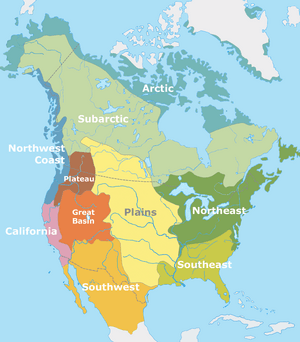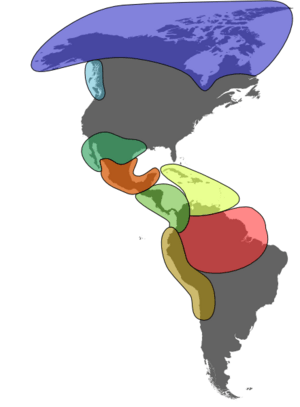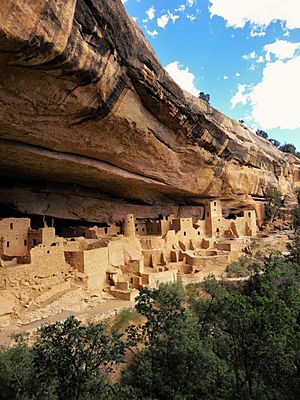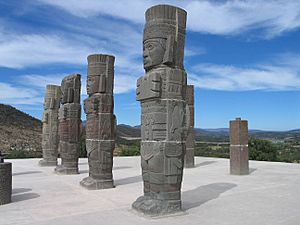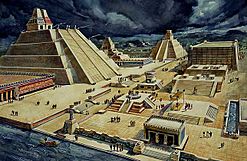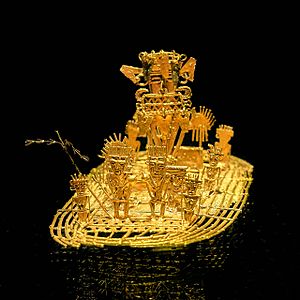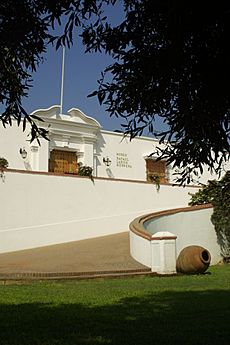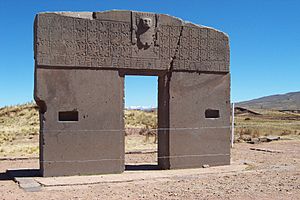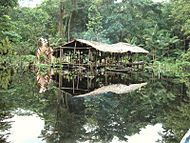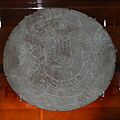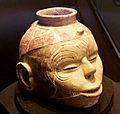Pre-Columbian facts for kids
The pre-Columbian era is a special time in the history of the Americas. It covers everything that happened on the American continents before people from Europe had a big impact.
The name "pre-Columbian" comes from Christopher Columbus, who first landed in the Americas in 1492. But sometimes, this era also includes the history of Indigenous cultures even after Columbus arrived. It covers the time until these cultures were taken over or greatly changed by Europeans, which could be many years or even centuries later.
This period also includes the amazing civilizations of the Americas, like the Aztec and Maya in Mesoamerica (which is like central America), and the Inca, Moche, and Chibcha people in the Andes mountains of South America.
Contents
First People in the Americas
Scientists believe that the first people to arrive in the Americas were Paleo-Indians. These were nomadic hunters from Asia. They likely crossed a land bridge called Beringia, which is now the Bering Strait, thousands of years ago. They might have also traveled along the coast.
Evidence from Indigenous peoples' DNA supports the idea that several groups of people migrated from Asia. After crossing the land bridge, they slowly moved south, spreading across North and South America over many thousands of years.
Exactly when the first people arrived is a big mystery and a topic of much discussion. One of the earliest known groups was the Clovis culture, whose sites date back about 13,000 years. However, some scientists believe people were here even earlier, possibly 20,000 years ago or more. Some genetic studies suggest the first people arrived between 40,000 and 13,000 years ago.
There are two main ideas about when people migrated:
- The short chronology theory suggests the first big movement into the Americas happened around 14,000–17,000 years ago.
- The long chronology theory proposes that people arrived much earlier, possibly 50,000–40,000 years ago.
Tools and other items found in both North and South America have been dated to about 14,000 years ago. This suggests that humans might have reached the very tip of South America by that time! The Inuit people, however, are thought to have arrived much later, perhaps only 2,000 years ago, by crossing the ice from Siberia to Alaska.
North America's Ancient Cultures
Early Hunter-Gatherers and Farmers
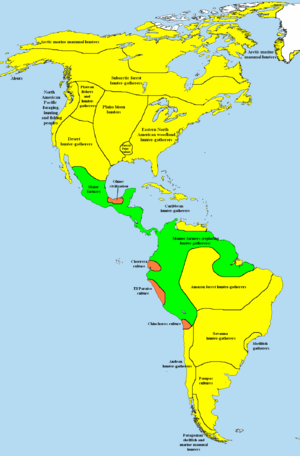
The climate in North America was changing a lot as the ice age ended. It finally settled down about 10,000 years ago, becoming similar to today's climate. During this time, known as the Archaic Period, many different cultures developed.
Early Paleo-Indian people were hunter-gatherers. They lived in small groups of about 20 to 50 family members. These groups moved around to find food. They hunted large animals that are now extinct, like mastodons and ancient bison. They used tools like sharp spear points and knives.
Because North America is so huge and has so many different climates and landscapes, the ancient peoples developed into many unique language and cultural groups. Their traditional stories often say that their people have lived in their land since the world began.
Over thousands of years, these people learned to grow plants. They domesticated and farmed many species, including crops that now make up a large part of the world's food, like corn. In colder, northern areas, people continued to hunt and gather. But in warmer, more protected regions, farming allowed populations to grow a lot.
Building Earth Mounds
It took thousands of years for the first complex societies to appear. The earliest ones started about 7,000 to 8,000 years ago. As early as 6500 BCE, people in the Lower Mississippi Valley built large earthwork mounds at a place called Monte Sano. These were probably for religious reasons.
These are the oldest known mound complexes in what is now Louisiana, Mississippi, and Florida. Archeologists have found that these mounds were built by hunter-gatherer societies. These people lived at the sites seasonally and had not yet developed pottery. Watson Brake, a huge complex of eleven platform mounds, was built starting in 3400 BCE. This discovery changed old ideas that complex buildings only appeared after societies started farming and settled down. These ancient people organized themselves to build these big projects in a different way.
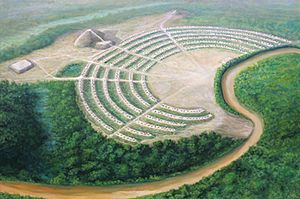
Before Watson Brake was accurately dated, Poverty Point in the Lower Mississippi Valley was thought to be the oldest mound complex. Built around 1500 BCE, it was the center of a culture with over 100 sites along the Mississippi River. The Poverty Point site has earthworks shaped like six half-circles, with paths dividing them, plus some mounds. The whole complex is almost a mile wide.
Later cultures continued to build mounds in the middle Mississippi and Ohio River valleys. They created effigy mounds (mounds shaped like animals), conical mounds, and other forms.
Woodland Period Cultures
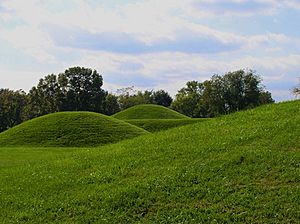
The Woodland period in North America lasted from about 1000 BCE to 1000 CE. During this time, the Adena culture and later the Hopewell tradition built huge earthwork structures. They also created trade networks that stretched across the continent.
This period saw steady development in tools made of stone and bone, leatherwork, textiles, and farming. Some Woodland peoples used spears and atlatls (spear throwers) until the end of the period, when bows and arrows became common.
Mississippian Culture
The Mississippian culture spread across the Southeast and Midwest of North America. A key feature of this culture was building large earthen mounds and grand plazas. They grew a lot of maize (corn) and other crops. They also had a large trade network and a complex society with different social levels.
The Mississippians appeared around 1000 CE. Their largest city, Cahokia, near modern East St. Louis, Illinois, may have had over 20,000 people. This made it the most populated city in North America at its peak (12th-13th centuries). Monk's Mound at Cahokia is the largest earthen structure built in the ancient Americas. The Mississippian culture began to decline in most places before Europeans arrived.
When Hernando de Soto and his Spanish expedition explored the American Southeast in the 1540s, they met many Mississippian peoples. This often ended badly for both sides. The Spanish brought new diseases, which devastated the local populations. By the time Europeans returned a hundred years later, most Mississippian groups had disappeared, and large areas were empty.
Southwestern Cultures
Ancestral Puebloans
The Ancestral Puebloans lived in the Four Corners region of the United States. Their culture likely began around 1200 BCE. They were a complex society that built kivas (special ceremonial rooms) and multi-story houses. These homes were made from stone and adobe, like the famous Cliff Palace at Mesa Verde National Park in Colorado and the great houses in Chaco Canyon, New Mexico. They also built a road system from Chaco Canyon.
Hohokam
The Hohokam lived in the Sonoran Desert in what is now Arizona and Mexico. They built many irrigation canals that helped establish modern cities like Phoenix. They also had large settlements like Snaketown, which was an important trading center. Around 1375 CE, the Hohokam society collapsed, probably due to drought, and they left their settlements.
Mogollon
The Mogollon lived in parts of Arizona, New Mexico, Texas, and Mexico. Like other cultures in this region, they built sophisticated kivas and cliff dwellings. At the village of Paquimé, the Mogollon kept scarlet macaws, which they traded from Mesoamerica.
Sinagua
The Sinagua were hunter-gatherers and farmers in central Arizona. They built kivas and great houses, as well as ballcourts. Some of their ruins include Montezuma Castle, Wupatki, and Tuzigoot.
Salado
The Salado lived in the Tonto Basin of Arizona from 1150 CE to the 15th century. Archeological finds show they traded with distant cultures, as seen by seashells from the Gulf of California and macaw feathers from Mexico. Many of their cliff dwellings are found in Tonto National Monument.
Other North American Cultures
Iroquois
The Iroquois League of Nations, also called the "People of the Long House," was a very advanced and democratic society. Some historians believe their political system influenced the United States Constitution. However, other historians disagree, pointing out many differences between the two systems.
Calusa
The Calusa were a powerful kingdom in southern Florida. Instead of farming, their economy relied on abundant fishing. Spanish records say the "king's house" at Mound Key was big enough for 2,000 people. The Calusa eventually died out around 1750, mostly due to diseases brought by Spanish colonists.
Wichita
The Wichita people were a group of farmers and hunter-gatherers in the eastern Great Plains. They lived in permanent settlements and even built a city called Etzanoa, which had 20,000 people. The city was abandoned around the 18th century after Spanish explorers found it.
Historic Tribes
When Europeans arrived, Indigenous peoples of North America had many different ways of life. Some were settled farmers, while others were semi-nomadic hunter-gatherers. Many formed new tribes or groups to deal with European colonization. These groups are often classified by cultural regions based on geography:
- Arctic (like the Inuit)
- Subarctic
- Northeastern Woodlands
- Southeastern Woodlands
- Great Plains
- Great Basin
- Northwest Plateau
- Northwest Coast
- California
- Southwest
Many pre-Columbian societies were settled, like the Tlingit and Chumash. Some built large settlements or even cities, such as Cahokia in what is now Illinois.
Mesoamerica's Great Civilizations
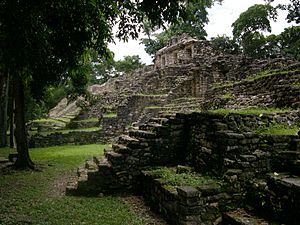
Mesoamerica is a region from central Mexico down to Costa Rica. It was home to many advanced farming civilizations that shared similar cultures, religions, art, and technology for about 3,000 years before Columbus arrived.
Between 2000 and 300 BCE, complex cultures began to form in Mesoamerica. Some grew into powerful civilizations like the Olmec, Teotihuacan, Maya, Zapotec, Mixtec, Huastec, Purepecha, Toltec, and Mexica/Aztecs. The Mexica are also known as the Aztec Triple Alliance, as they were three smaller kingdoms working together.
These Indigenous civilizations made many amazing inventions. They built pyramid-temples, developed mathematics, astronomy, medicine, and writing. They created very accurate calendars, beautiful art, and advanced farming methods. They also invented the wheel, but mostly used it for toys. They worked with native copper, silver, and gold.
Early markings on rocks in northern Mexico show they had a system for counting. Their number system was base 20 and included the concept of zero. Many later Mesoamerican cities were built to align with specific astronomical events.
The biggest Mesoamerican cities, like Teotihuacan, Tenochtitlan, and Cholula, were among the largest in the world. They were centers for trade, new ideas, ceremonies, and religion, influencing cultures around them.
Five major civilizations stood out in Mesoamerica: the Olmec, Teotihuacan, the Toltec, the Mexica (Aztec), and the Maya. They spread their power and influence through trade, art, politics, and technology. Other groups formed alliances or went to war with them, but most were influenced by these powerful civilizations.
Trade routes connected areas from central Mexico down to the Pacific coast and even into Central America. These networks helped spread ideas and goods for thousands of years.
Olmec Civilization
The Olmec were the earliest known civilization in Mesoamerica. They set the cultural foundation for many later civilizations in Mexico. Olmec culture began with a lot of pottery production around 2300 BCE. By 1600-1500 BCE, the Olmec civilization was strong, with its capital at San Lorenzo Tenochtitlán. Their influence spread across Mexico and into Central America. They changed how people thought about government, pyramid-temples, writing, astronomy, art, math, and religion. Their achievements paved the way for the Maya and other central Mexican civilizations.
Teotihuacan Civilization
After the Olmec declined, Teotihuacan rose to power. It was first settled in 300 BCE. By 150 CE, Teotihuacan became the first true large city in what is now North America. It created a new economic and political system in Mexico. Its influence reached across Mexico and into Central America, even starting new ruling families in Maya cities like Tikal and Copan. Teotihuacan's impact on the Maya was huge, changing their politics, art, and economy. The city of Teotihuacan had a diverse population, with people from different parts of Mexico living and working there. Teotihuacan's power declined around 650 CE, but its cultural influence lasted for centuries.
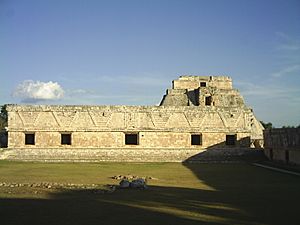
Tarascan/Purepecha Civilization
The Tarascan Empire was formed around 1300 CE when Tariacuri united several communities. Their capital was Tzintzuntzan, and they controlled many other cities. The Tarascan Empire was one of the largest in Central America and often fought with the neighboring Aztec Empire.
The Tarascans were known for their advanced metalworking, using copper, silver, and gold to make tools, decorations, and even weapons. They often defeated the Aztecs in wars. Unlike the Aztecs and Maya, the Tarascans had a very unique culture and religion because they were not directly influenced by the earlier Toltec Empire.
Maya Civilization
The Maya civilization flourished at the same time as Teotihuacan, especially between 250 CE and 650 CE. While the many Maya city-states were never politically united, they had a huge intellectual influence on Mexico and Central America. The Maya built some of the most complex cities on the continent. They made great advances in mathematics, astronomy, and calendars. The Maya also developed the only true writing system in the Americas, using pictures and symbols on stone, pottery, wood, and books made from bark paper.
Huastec Civilization
The Huastecs were a Maya group who moved north to the Gulf Coast of Mexico. They are considered separate from the main Maya civilization because they split off around 2000 BC and did not use the Maya script. Some also suggest they migrated after the Classic Maya collapse around 900 AD.
Zapotec Civilization
The Zapotecs lived in the Oaxaca Valley from the late 6th century BC until the Spanish arrived. The city of Monte Albán was an important religious center and their capital from 700 BCE to 700 CE. The Zapotecs resisted the Aztecs until they were taken over in 1502. After the Spanish conquest of the Aztec Empire, the Zapotecs continued to resist Spanish rule for a while.
Mixtec Civilization
Like the Zapotecs, the Mixtecs lived in the Oaxaca Valley. They were made up of many independent kingdoms rather than one empire. The Mixtecs were eventually conquered by the Aztecs. When the Spanish arrived, many Mixtecs saw it as a chance to be free from Aztec rule and allied with the Spanish.
Totonac Civilization
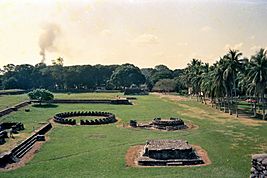
The Totonac civilization was mainly in the states of Veracruz and Puebla. They built important trading cities like El Tajín. The Totonacs helped the Spanish conquer the Aztec Empire, hoping to free themselves from Aztec control.
Toltec Civilization
The Toltec civilization began in the 8th century CE. Their empire expanded south to the Yucatán peninsula, including the Maya city of Chichen Itza. The Toltecs had extensive trade with other Mesoamerican civilizations and even with the Puebloans in New Mexico. During the later Post-Classic era, the Toltecs declined in the early 12th century due to famine and civil war. The Toltec civilization was so influential that many later groups, like the Aztecs, claimed to be descended from them.
Aztec/Mexica/Triple Alliance Civilization
After the Toltec civilization declined, the Valley of Mexico became politically divided. The Mexica people, who were outsiders, stepped into this power struggle. They were one of seven groups who called themselves "Azteca" but changed their name after migrating. At first, they were seen as less refined than the local groups. But through clever political moves and fierce fighting skills, they came to rule Mexico as the head of the 'Triple Alliance' with two other Aztec cities, Tetxcoco and Tlacopan.
The Mexica-Aztecs saw themselves as the heirs of earlier civilizations. They valued the arts, sculpture, architecture, and the calendar, believing these were gifts from the Toltecs.
By about 1400, the Mexica-Aztecs ruled much of central Mexico. At their peak, the Valley of Mexico had nearly 1 million people during the late Aztec period (1350–1519).
Their capital, Tenochtitlan, is where modern-day Mexico City stands. At its peak, it was one of the largest cities in the world, with an estimated population of 200,000–300,000. The market there was the biggest the Spanish explorers had ever seen.
Tlaxcala Republic
Tlaxcala was a Nahua republic and group of states in central Mexico. The Tlaxcalans strongly resisted Aztec expansion for many years. They later allied with the Spanish explorers under Hernán Cortés to free themselves from the Aztecs. With Spanish help, they successfully conquered the Aztecs. The Spanish rewarded the Tlaxcalans by allowing them to keep their culture. The Tlaxcalans also helped the Spanish in other conquests.
Cuzcatlan
Cuzcatlan was a Pipil group of kingdoms and city-states in what is now El Salvador. Legend says it was founded by Toltec migrants around 1200 AD. During the Spanish conquest of El Salvador, Cuzcatlan was forced to surrender to Pedro de Alvarado in 1528.
Lenca
The Lenca people were made up of several different language groups and city-states in what is now El Salvador and Honduras. Cities like Yarumela were important trade centers for the Lenca. During the Spanish conquest, some Lenca leaders resisted, while others accepted Christianity peacefully.
Nicarao
The Nicarao people, an offshoot of the Pipil, were a group of tribes that thrived in what is now Nicaragua. Their migration might have led to the fall of Teotihuacan and the Toltec city of Tula. The Nicarao civilization ended during the Spanish conquest of Nicaragua in 1522.
Nicoya Kingdom
The Nicoya kingdom was a monarchy in the Nicoya peninsula of Costa Rica. It existed from 800 CE until the Spanish arrived in the 16th century.
South America's Ancient Cultures
By the first millennium, South America's vast rainforests, mountains, plains, and coasts were home to millions of people. Some estimates suggest 30–50 million, and some even 100 million. Many groups formed permanent settlements. These included Chibcha-speaking peoples (like the Muisca), Valdivia, Quimbaya, Calima, Marajoara culture, and the Tairona. The Muisca of Colombia, Valdivia of Ecuador, and the Quechuas and Aymara of Peru and Bolivia were four of the most important settled Indigenous groups in South America. Since the 1970s, many geoglyphs (large designs on the ground) have been found in the Amazon rainforest, supporting stories of complex ancient Amazonian civilizations like Kuhikugu.
There's a theory that people from South America might have had contact with Polynesia across the Pacific Ocean before Columbus. This idea is supported by some plants, like the sweet potato, that are native to South America but were found in Oceania before Europeans arrived. However, clear archaeological evidence of people traveling between these places is still missing.
Norte Chico Civilization

On the north-central coast of Peru, the Norte Chico or Caral civilization emerged around 3000 BCE. This was around the same time cities were rising in Mesopotamia. It had many large urban settlements, with the Sacred City of Caral being one of the largest and best studied. This civilization did not use machinery or pottery but still developed trade, especially in cotton and dried fish. It was a society with different social levels that managed its environment well and traded with other cultures. Its economy relied heavily on farming and fishing. Caral is considered one of the earliest civilizations in the world and the oldest known civilization in the Americas.
Valdivia Culture
The Valdivia culture was located on the coast of Ecuador. Their existence was recently discovered through archaeological finds. Their culture is one of the oldest in the Americas, lasting from 3500 to 1800 BCE. The Valdivia people lived in houses built in a circle or oval around a central plaza. They were settled farmers and fishers, though they sometimes hunted deer. They grew maize, kidney beans, squash, cassava, chili peppers, and cotton for clothing. Valdivian pottery started simple but became very detailed and artistic over time.
Cañari People
The Cañari were Indigenous people from what are now the Cañar and Azuay provinces in Ecuador. They were an advanced civilization with impressive architecture and complex religious beliefs. The Inca destroyed most of their remains. The Cañari's old city was replaced by the Incan city of Tumebamba and later by the Spanish city of Cuenca. This city was also thought to be the site of El Dorado, the legendary city of gold.
The Cañari are famous for fiercely resisting the Incan invasion for many years before finally falling to Tupac Yupanqui. Many of their descendants still live in Cañar and have kept their culture.
Chavín Civilization
The Chavín, a Peruvian civilization that did not use writing, built a trade network and developed farming by 900 BCE. Artifacts have been found at a site called Chavín in modern Peru, high in the mountains. The Chavín civilization lasted from 900 to 300 BCE.
Muisca Confederation
The Chibcha-speaking communities were the largest and most developed pre-Hispanic groups in Colombia. By the 8th century, they had established their civilization in the northern Andes. They occupied parts of what is now Panama and the high plains of eastern Colombia.
The areas they lived in Colombia are now the richest parts of the country. The Chibcha developed the most populated region between the Maya area and the Inca Empire. Along with the Quechua of Peru and the Aymara in Bolivia, the Chibcha developed a very notable culture among the settled Indigenous peoples in South America.
In the Colombian Andes, the Chibcha included several tribes who spoke similar languages, such as the Muisca, Guane, and Lache.
Tairona Confederation
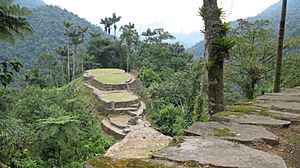
The Tairona civilization thrived in the Sierra Nevada de Santa Marta mountains in northern Colombia. Studies suggest they flourished from the 1st century CE until the Spanish arrived in the 16th century. The descendants of the Tairona, like the Kogi, were among the few Indigenous groups in the Americas who largely avoided full colonial conquest and kept most of their traditional cultures.
Moche Civilization
The Moche lived on the north coast of Peru from about 100 to 800 CE. Their legacy is seen in their elaborate burials, some of which have been recently excavated.
The Moche were skilled artisans and technologically advanced. They traded with distant peoples like the Maya. Much of what we know about the Moche comes from studying their ceramic pottery, which shows details of their daily lives. The Larco Museum in Lima, Peru, has a large collection of these ceramics.
Wari Empire
The Wari empire was in western Peru and existed from the 6th to the 11th century. Wari, their former capital city, was the center of a civilization that covered much of Peru's highlands and coast. Well-preserved ruins include the Wari Ruins and the Northern Wari ruins.
Tiwanaku Empire
The Tiwanaku empire was based in western Bolivia and spread into parts of Peru and Chile from 300 to 1000 CE. Tiwanaku is considered one of the most important South American civilizations before the Inca Empire. It was a major state's religious and administrative capital for about 500 years. The ruins of this ancient city are near Lake Titicaca.
Inca Empire

The Inca civilization, with its capital at the great cougar-shaped city of Cusco, Peru, ruled the Andes region from 1438 to 1533. Called Tawantinsuyu, or "the land of the four regions," in Quechua, the Inca civilization was very unique and developed. Inca rule covered nearly a hundred different language or ethnic groups, about 9 to 14 million people, connected by a 40,000-kilometer road system. Their cities were built with precise stonework on mountain slopes. Terrace farming was a very effective way to grow crops. There is also evidence of excellent metalwork and even successful brain surgery in Inca civilization.
Aymara Kingdoms
The Aymara kingdoms were a group of separate states that lasted from 1151 after the fall of Tiwanaku until 1477, when they were conquered by the Inca Empire. The Aymara kingdoms were mostly in the Altiplano in Bolivia, as well as parts of Peru and Chile.
Arawaks and Caribs
Archaeologists have found evidence of the earliest known people in Venezuela, including leaf-shaped stone tools, dating from 13,000 to 7000 BCE. These early groups lived alongside giant animals like megatherium.
From 7000–5000 CE to 1000 CE, hunters and gatherers started using other food sources and formed the first tribal structures. After 1000 CE, the Neo-Indian period began, ending with the European conquest.
We don't know exactly how many people lived in Venezuela before the Spanish Conquest, but it might have been around a million. This included groups like the Arawaks, Caribs, and Timoto-cuicas. The population greatly decreased after the Conquest, mainly due to new diseases from Europe. Indigenous peoples in Venezuela had already found crude oil and asphalt. They used this thick, black liquid for medicine, light, and to seal canoes.
In the 16th century, when Spanish colonization began in Venezuela, the population of several Indigenous peoples like the Mariches declined.
Diaguita Confederation
The Diaguita consisted of several distinct groups in the Argentine Northwest. Their culture emerged around 1000 CE. The Diaguita resisted Spanish colonialism during the Calchaquí Wars until they were forced to surrender in 1667.
Taíno
The Taíno people were divided into many chiefdoms across the Greater Antilles, the Lucayan Archipelago, and the northern Lesser Antilles. The Taíno were the first pre-Columbian people to meet Christopher Columbus during his voyage in 1492. The Spanish colonists later enslaved the Taíno, and they were considered almost extinct by 1565.
Huetar Kingdoms
The Huetar people were a major ethnic group in Costa Rica. They were made up of several independent kingdoms. After being taken over by the Spanish, the descendants of the Huetar now live in the Quitirrisí reserve.
Marajoara Culture
The Marajoara culture flourished on Marajó Island at the mouth of the Amazon river in northern Brazil between 800 and 1400 CE. The Marajoara had a complex society that built mounds and sophisticated settlements. They used terra preta (rich, dark earth) for large-scale farming, which supported their complex chiefdoms. Studies suggest the civilization had around 100,000 people.
Kuhikugu
Located in the Xingu Indigenous Park in Brazil, Kuhikugu was a complex urban area with about 50,000 people and 20 settlements. This civilization was likely built by the ancestors of the Kuikuro people. They built roads, bridges, and trenches for defense. They were also farmers, growing cassava and using terra preta. Like many other Amazonian civilizations, Kuhikugu likely disappeared due to Old World diseases brought by European colonists.
Cambeba
Also known as the Omagua, the Cambeba are an Indigenous people in Brazil's Amazon basin. The Cambeba were a large, organized society in the late pre-Columbian era. Their population greatly declined in the early years of the Columbian Exchange due to diseases. The Spanish explorer Francisco de Orellana traveled the Amazon River in the 16th century and reported densely populated regions along the river. These populations left no lasting stone monuments, possibly because they used local wood for building. Archaeological evidence shows they had semi-domesticated orchards and vast areas of land enriched with terra preta, suggesting a large and organized civilization existed there.
Farming and Animals
Early inhabitants of the Americas developed amazing agricultural skills. They transformed wild plants into the large, familiar maize (corn) we know today. Other important plants grown by natives include Potatoes, tomatoes, pumpkins, chili peppers, squash, beans, pineapple, sweet potatoes, quinoa, amaranth, cocoa beans, vanilla, onion, peanuts, strawberries, raspberries, blueberries, blackberries, papaya, and avocados. Over two-thirds of all food crops grown worldwide today are native to the Americas!
Early Indigenous peoples also used fire widely. They intentionally burned vegetation to clear forest floors, making travel easier and helping herbs and berry plants grow. This created the Pre-Columbian savannas of North America.
While not as common as in Europe or Asia, Indigenous Americans did have some livestock. Domesticated turkeys were common in Mesoamerica and parts of North America. They were valued for meat, feathers, and eggs. Some Mesoamericans also ate hairless dogs, especially the Xoloitzcuintle breed. In the Andes, societies raised llamas and alpacas for meat and wool, and as pack animals. Guinea pigs were raised for meat in the Andes. Other wild animals like deer and pecari were also hunted for meat in Mexico, Central, and northern South America.
By the 15th century, maize had spread from Mexico and was being farmed in the Mississippi embayment, all the way to the East Coast of the United States, and as far north as southern Canada. The Inca used potatoes, and the Aztecs used chocolate.
Images for kids
-
Monks Mound of Cahokia (UNESCO World Heritage Site) in summer. The concrete staircase follows the approximate course of the ancient wooden stairs.
-
An artistic recreation of The Kincaid site from the prehistoric Mississippian culture as it may have looked at its peak 1050–1400 CE
-
Engraved stone palette from Moundville, illustrating two horned rattlesnakes, perhaps referring to The Great Serpent of the Southeastern Ceremonial Complex
Related pages
See also
 In Spanish: América precolombina para niños
In Spanish: América precolombina para niños


